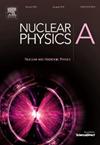Nuclear mass density effect of 27Al and 28Si nuclei in nuclear reactions
IF 2.5
4区 物理与天体物理
Q2 PHYSICS, NUCLEAR
引用次数: 0
Abstract
In a recent study, diffuseness parameters of and were proposed for the nuclear matter density of Si and Al, respectively, based on the two-parameter Fermi distribution. These values exceed the systematic value , commonly adopted in the São Paulo potential. To assess the validity of the proposed parameters, we performed coupled-channel calculations for the systems Be+Si, N+Si, C+Si, Be+Al, N+Al, and Si+Al at energies 2-3 times the Coulomb barrier. The analyses were carried out using the FRESCO code, with the Sao Paulo Potential and Woods-Saxon potential used as the optical potential. A good description of elastic angular distributions was achieved with the systematic nuclear matter density diffuseness value of .
27Al和28Si核在核反应中的质量密度效应
在最近的一项研究中,基于双参数费米分布,分别提出了28Si和27Al核物质密度am=0.62fm和am=0.65fm的扩散参数。这些值超过了圣保罗电势通常采用的系统值am=0.56fm。为了评估所提出参数的有效性,我们对9Be+28Si、14N+28Si、13C+28Si、9Be+27Al、14N+27Al和28Si+27Al系统进行了能量为库仑势垒2-3倍的耦合通道计算。使用FRESCO代码进行分析,使用圣保罗势和伍兹-撒克逊势作为光势。系统核物质密度扩散值am=0.56fm,较好地描述了弹性角分布。
本文章由计算机程序翻译,如有差异,请以英文原文为准。
求助全文
约1分钟内获得全文
求助全文
来源期刊

Nuclear Physics A
物理-物理:核物理
CiteScore
3.60
自引率
7.10%
发文量
113
审稿时长
61 days
期刊介绍:
Nuclear Physics A focuses on the domain of nuclear and hadronic physics and includes the following subsections: Nuclear Structure and Dynamics; Intermediate and High Energy Heavy Ion Physics; Hadronic Physics; Electromagnetic and Weak Interactions; Nuclear Astrophysics. The emphasis is on original research papers. A number of carefully selected and reviewed conference proceedings are published as an integral part of the journal.
 求助内容:
求助内容: 应助结果提醒方式:
应助结果提醒方式:


